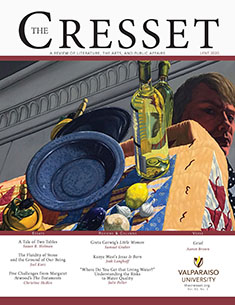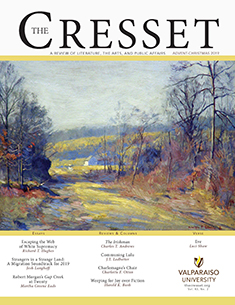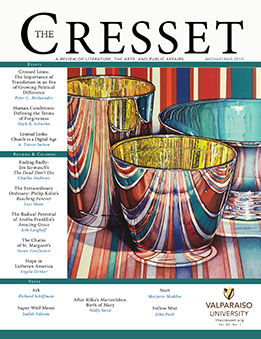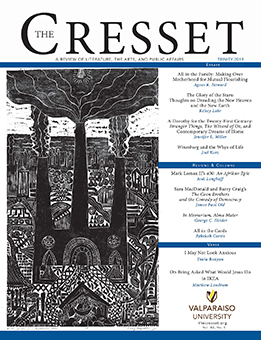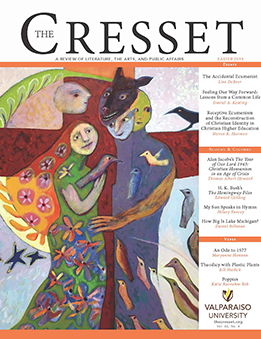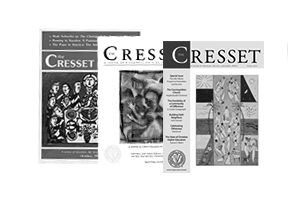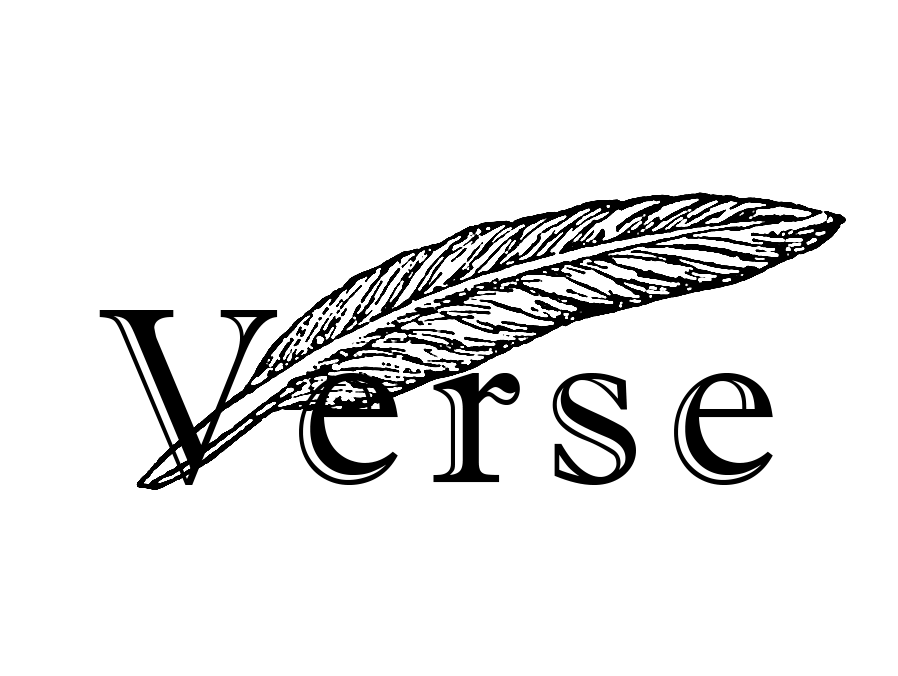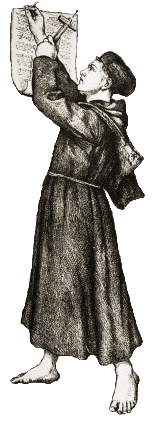Youth loves iconoclasts. I remind myself of that fact every time Chicago Bull rainbow head Dennis Rodman does something else outrageous and further endears himself to America's young people. Rodman is a pest, but he's probably not quite the monster the media sometimes portray him. Still, if youth is to find a rebellious hero, we could all wish for someone with greater substance, with a message that transcends the joys of hair dyeing, tattoos and body piercing. I hesitate to plunge on from here, we boomers always feeling so superior to the generation following our own. But a Gen-X student of mine probably got it pretty close to right when he responded to my unsolicited criticism of what I termed his age group's "lack of focus." The difference between his generation and mine, he explained, was that the students of the sixties "had some pretty straightforward things to be against."
I think the boomers should probably remember, however, that some of our heroes grew into the job a while after we had become their fans. The Beatles went on to write great, complex music that commented with fervor and insight on social and political issues. But when we first fell in love with them they were mostly proclaiming, "Yeah, yeah, yeah" and "twist and shout," in the universal advocacy of men combing their hair forward toward their eyebrows instead of backwards off their foreheads. Comparably, when a lot of us first fell in love with Cassius Clay, long before he became Muhammad Ali, his primary pronouncements were, "I am the prettiest man I ever met," and, of course, "I am the greatest."
All of this is a way of introducing the topic of Leon Gast's terrific documentary "When We Were Kings, a behind the scenes account of the world title heavyweight boxing match between Muhammad Ali and George Foreman in November of 1974, the storied "Rumble in the Jungle." Gast took twenty-three years getting this film to the screen. It took him that long to raise enough money to edit hundreds of hours of film into a single feature. Part sociological treatise, part dynamic sports flick, the movie chronicles a championship, a champion and an era of transformation. When We Were Kings won the 1997 Oscar for best documentary and thoroughly deserved it.
Why Boxing?
Admitting to being a boxing fan is hardly politically correct, all the less so in the aftermath of Mike Tyson's barbarous ear biting in his recent championship bout against Evander Holyfield. And I'll quickly concede that the sport is brutal and subject to disheartening corruption. Promoters with the questionable ethics of Don King get rich. Boxers like Joe Louis and Muhammad Ali get brain damage. Head cases like Mike Tyson continue getting championship fights when what they need is psychiatric treatment. But all that admitted, I'll own up to being a boxing fan. It is the most primal of sports, one man alone against another, each figuratively (and almost literally) naked except for his skill, conditioning, cunning and will. Yes, it is sometimes the circumstance of gruesome violence, but at its best it is also terrific theater and the occasion of astonishing courage. In addition, throughout the twentieth century, the boxing ring has provided an arena for a series of morality plays, until the retirement of Rocky Marciano in 1956, many of them having directly to do with race, white versus black. A decade before Jackie Robinson broke the color barrier in major league baseball, few African Americans failed to thrill at the dozen-year reign of heavyweight boxing champion Joe Louis.
After Marciano's retirement, the only Caucasian to hold the heavyweight crown was a Swede named Ingemar Johansson who reigned as champion for a year in 1959 and 1960. Black-white struggles were relentless in the popular middleweight division, however, and I grew up fascinated by the battles of six-time middleweight champion Sugar Ray Robinson who won and lost a series of title bouts against such white opponents as Jake LaMotta, Bobo Olson, Carmen Basilio and Gene Fulmer. In my liberal household, we rooted for Robinson.
I think the first thing that attracted me to Casius Clay was his early pronouncement that he was going to bring the boxing style of Ray Robinson to the heavyweight arena. Heavyweights were traditionally sluggers who stood in the middle of the ring and pounded each other until one fell over, usually in the early rounds. But Clay promised to "float like a butterfly and sting like a bee." He promised to meet brute force with athletic grace. And he made good on that promise for nearly two decades. As he liked to say about his repeated declarations of self-praise, "it ain't bragging if it's true."
Hitting and Catching
Casius Clay made his first appearance on the world athletic stage in 1960 at the Olympic Games in Rome where he won the gold medal as a light-heavyweight. Several weeks later when he was refused service in a diner in his hometown of Louisville, Kentucky, an outraged Clay threw his medal into the Ohio River (he was given a replica at the 1996 games in Atlanta). Clay came to prominence at a time athletes were supposed to be modest about their accomplishments. But the boxer figured that self-promotion was the fastest way to open doors for himself. He talked so much, so fast, so articulately and so outrageously that he was dubbed the Louisville Lip. And indeed, when he landed his first heavyweight title fight against Sonny Listen in February of 1964, many boxing experts felt that he'd gotten his shot at a championship not by earning it in the ring (he was undefeated, but his list of conquered opponents was suspect) but by annoying people who were anxious to see the ferocious Liston teach him some manners.
The civil rights movement was at its height in 1964, the year Martin Luther King would win the Nobel Peace Prize. And the majority of white America, either indifferent or overtly hostile to an increasingly assertive black America, found itself without a clear favorite in the Clay-Liston fight. Liston was a convicted felon who had done jail time and had twice destroyed the polite and popular Floyd Patterson with devastating first-round knockouts, first to take Patterson's crown in 1962 and again in a 1963 rematch. White America thought of Liston as a thug and hungered for somebody to beat him, somebody white preferably, but in the absence of proper skin color, somebody nice (like Patterson who was clearly not up to the assignment) but absolutely not somebody like Cassius Clay who was an obnoxious blowhard, the very kind of pushy Negro that was causing such trouble at bus stations, lunch counters and voter registration desks.
Critically, though, no one gave Clay a chance. Liston was considered unbeatable. He had immense strength. He was a crushing puncher. And Clay had just talked himself into a fight he didn't deserve. The experts disagreed only about how long it would take Liston to knock Clay out. There can be no question that Sonny Liston was a fearsome slugger, but as Cassius Clay pointed out, "you can't hit what you can't catch." The fight itself was nothing short of astonishing. Clay came out in the first round doing his famous "shuffle," moving backwards, circling away, usually to his left. Taunting Liston as "a big ugly bear," Clay did not even raise his own gloves, holding his hands below his waist for the entire round. He threw no punches. He simply defied Listen to hit him. Liston was infuriated. He stalked forward unloading one thunderous roundhouse after another, but he managed to hit only air.
Clay began to box after the first round, sticking Liston repeatedly with his lightning quick left jab. But the fight was decided in the first round. The crucial psychological battle was already over. The invincible Sonny Liston had been embarrassed. Mentally humiliated, physically exhausted, he refused to come out for the seventh round. Cassius Clay was heavyweight champion of the world. And then Clay delivered a knockout blow to white America. He announced that he was a disciple of Malcolm X, the nation's angriest black leader and a minister in the separatist Nation of Islam. Henceforth Clay would be called Muhammad Ali, a name, the boxer explained, that meant "worthy of praise."
The country didn't know what to make of Muhammad Ali in 1964. Many in white America dismissed Ali's victory over Liston as the result of a fix. Many thought his name change and association with the Black Muslims was just another in a long series of publicity stunts, another instance of his defiling the rules of polite behavior. The nation was slow to learn that Muhammad Ali was a man of his word. In boxing terms, he was the greatest indeed. From 1964 to 1967 no boxer approached his skills. He fought and defeated all comers.
Meanwhile, uncomfortable as he made middle-class white America, Ali was achieving a spectacular popularity. His iconoclasm had already made him attractive to the youth of the sixties. But in 1967 he became one of the era's great heroes when he refused induction to serve in the United States army in Vietnam. The antiwar movement was just gathering momentum, and Muhammad Ali was in its forefront declaring, "Keep asking me no matter how long/ On the war in Vietnam I sing this song/1 ain't got no quarrel with the Viet Cong." Asked how he could express such an attitude about America's enemy, Ali added, "No Viet Cong ever called me 'nigger.'"
Ali was beloved of the thousands of young Americans opposed to the war in Vietnam. More than that, he became a hero to people all over the world who resented the American government's ham-handed approach to international relations in the decades after World War II. Ill-at-ease white Americans tried to characterize Muhammad Ali as a clown. They discovered he was a man of principle. But his athletic standing paid a heavy price for those principles. He was indicted and convicted for draft evasion by an all-white jury, and his heavyweight title was stripped by the professional boxing commissioners. Denied the opportunity to earn his living in the ring, he supported himself for three years making speeches on college campuses. He was not allowed to box again until the U.S. Supreme Court overturned his conviction in 1970.
Before trying to regain his heavyweight title, Ali quickly fought several warm-up bouts against over-matched opponents. Then in March of 1971 he faced the reigning champion, Joe Frazier, in a fifteen-round championship fight. But he fought too soon, he was still rusty from his three-year layoff, and those of us who loved him were crushed when the unanimous decision went against him. The fight was competitive and went the distance, and unlike so many beaten fighters, Ali accepted his defeat gracefully. When he subsequently lost to Ken Norton and suffered a broken jaw in the process, the experts maintained that he was finished and should retire.
Meanwhile in January of 1973, George Foreman knocked out Joe Frazier, hitting Frazier so hard with a second-round upper cut that he actually lifted Frazier off the mat. After that Foreman beat Ken Norton just as badly and just as quickly. Foreman was like Sonny Liston reincarnated. He was huge, and he was devastating. Boxers were actually afraid to get into the ring with a man so powerful. And boxing authorities were skeptical that anyone could make a decent appearance against Foreman. Surely no one could beat him. And certainly not the aging Ali. When people talked of Ali facing Foreman, just as had been true ten years previously, the only thing the pundits disagreed about was how long Ali could last against the most fearsome fighter in the world. The experts conceded now that Ali had been a great champion in the 1960s, but everybody presumed he could never recover his former glory. Boxing promoters across America figured the fight would never take place.
Promotion
Enter a dark-haired, fast-talking, still youthful Don King. King offered Foreman and Ali five million dollars each to fight, immense sums for the time. All King needed was the money, which he didn't have. He couldn't find it, moreover, anywhere in the United States where everyone deemed Ali washed up. So King peddled the fight not to a promoter but to a president, to Mobutu Sese Seko, the reigning dictator of Zaire. Defending Mobutu's investment, Ali argued, "Countries go to war to put their names on the map, and wars cost a lot more than ten million dollars."
The fight was scheduled for late September of 1974, and King arranged that it be accompanied by a huge music festival featuring James Brown and B.B. King, among others. When We Were Kings director Gast landed a contract with King to make a documentary of the festival, as he envisioned it, a kind of African Woodstock. But Foreman was injured in training and the fight was delayed for six weeks, during which time Gast shot thousands of feet of film with Ali. The result is a documentary focusing on Ali and the fight.
As the fighters and their entourages gathered for the fight in Kinshasa, a host of things were at stake, of which the heavyweight crown was only the most immediately obvious. At age 32, clearly on the downslope of his career, Ali remained one of the most controversial athletes in America and one of the most popular figures in the world. He was particularly popular in Africa because of his connection to Islam.
George Foreman, meanwhile, though champion, was not widely known outside of the United States. And those abroad who did know him didn't like him. Whereas Ali's anti-war stance was celebrated outside the United States and by peace activists at home, Foreman was remembered as the man who waved little American flags after winning a gold medal in the turbulent Olympics at Mexico City. His patriotic gesture may have pleased some at home, but it angered millions overseas.
American African
Spike Lee reminds us in When We Were Kings that there was a time not so long ago in our country when a black American was insulted to be identified as African. That attitude had changed in the late 1960s and early 1970s when the term "Afro-American" enjoyed a passage of popularity in the black community. And if the film's seeming implication that the Rumble in the Jungle transformed black America's attitudes toward Africa is too strong, the fight and the charismatic performance of Ali certainly gave a popular boost to Afrocentrism.
From the beginning of the fight promotion through the celebration of his victory, Ali continually identified himself with the African people. And they loved him. He was a black hero who had defied the American government and made common cause with people of color around the globe. Throughout his training, wherever he went in Zaire, Ali was greeted with chants of "Ali, Bomaye" which translated, "Ali, kill him." Throughout Africa, many indigenous people thought George Foreman was a white man. Foreman was hurt and confused by all this, but that made him all the more determined to punish Ali in the ring.
Muhammad Ali was a great boxing champion, quite probably the best who ever laced on a pair of gloves. But there's no question his skill had diminished by the time he fought George Foreman at 4 a.m. (for the benefit of American closed-circuit television) in Kinshasa. Legend has it that Foreman took Ali lightly and that Ali planned his famed "rope-a-dope" strategy for weeks. When We Were Kings gives the lie to both those notions. Ali knocked George Foreman out with his fists, but he beat him with his brains. Foreman was not only a devastating puncher, perhaps the most powerful of all time, he also was a superior ring tactician with excellent footwork, not merely a lumbering strong man like Sonny Liston. Ali promised to stick and move, "to dance like I got ants in my pants" and Foreman painstakingly trained to cut off his avenues of retreat, to corner and pummel him. If Ali hadn't outsmarted him, Foreman almost surely would have won, and Ali knew that better than anyone else.
Ali's long-time advocate Howard Cosell editorialized that to win Ali needed "a miracle." In the film Norman Mailer explains with brilliant clarity how Ali obviously felt that to win he had to knock Foreman out in the fight's opening minutes. To that end Ali repeatedly threw the right-hand lead, a punch considered incredibly dangerous because it left him so wide open for a left hook counter. And Foreman possessed one of the deadliest left hooks in boxing. Professional boxers simply don't throw the right-hand lead. But Ali figured such an unconventional strategy was perhaps his one chance, to hit Foreman with a punch Foreman would never expect. Ali threw the right-hand lead twelve times in the first round, many of them catching Foreman flush in the jaw. But to Ali's astonishment and dismay his punches landed on Foreman's face without noticeable effect. Only then, only having failed in what he had devised as his one best hope, did Ali make up something else, the "rope-a-dope." He lay on the ropes, leaning as far out of the ring as possible to protect against a powerful blow to the head and allowed Foreman to flail away, taunting Foreman all the while, until the bigger, stronger, younger man had worn himself out.
This was not a strategy but an innovation. It was like Bobby Fischer moving a knight to an outside file. It was contrary to all that was considered wisdom about the sport. And it was an act of genius. Ali took blows on his arms and elbows, but Foreman couldn't reach him to knock him out. And by the eighth round Foreman was spent. Sensing it, Ali sprung off the ropes and hammered him with a combination that ended with a punishing right to the head. As Foreman started down, Ali cocked another right that he never threw. Foreman tumbled to the canvas and into a depression that lasted for two years and spawned a premature retirement. When he reemerged on the American public scene a decade later, he was an entirely new person. He had won a fight with himself that was greater even than his fight against Ali. And if I could ask one thing of When We Were Kings that it does not deliver, it would be footage exhibiting the charm and humor Foreman found within himself when he came to understand that losing to Muhammad Ali was nothing to be ashamed of.
When We Were Kings does not restrict itself to boxing. It shows us touching footage of Ali interacting with African children, many of whom could not conceivably understand who he was. And it establishes beyond dispute Ali's obvious liking for his fellow man. Still, as pure sports theater, the documentary is nothing short of thrilling. In 1974, as Ali pirouetted around the falling Foreman, holding a punch he might have thrown but never did, he ascended to the rank of legend, his fascinating personality and supreme athletic skills placing him in the company of Jackie Robinson as a man who merged the worlds of sport and sociology. The amazing thing to me about Ali is how affable he remained despite his self-promoting bombast. His bragging was always done with a wink. Meanwhile, he took serious stands on serious issues. He spoke his mind with uncommon honesty and candor. But he never gave in to anger. He exhibited astounding courage in enduring the thieving of his youth. And he did so without ever resorting to hatred. He stands in the first rank of the heroes my generation has every reason to remain proud of. As George Plimpton says about him in the film's benediction, "What a fighter. What a man."


